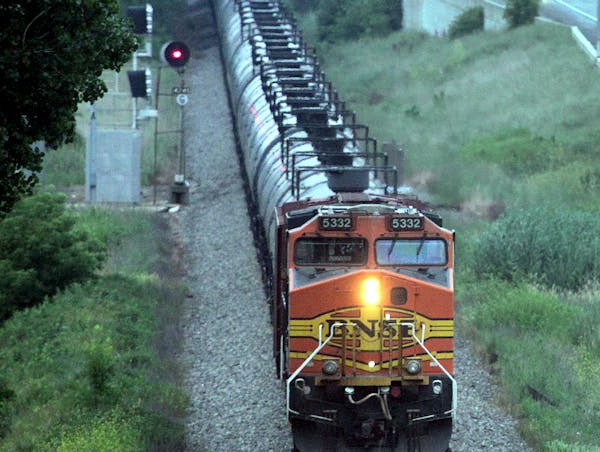The noise rattled Curt Benson's home like thunder.
"I heard an explosion, loud enough that I could hear it inside my house with the radio on, and I knew it couldn't be good," said Benson, a retired Washington state sheriff who had returned to his hometown of Heimdal, N.D., for some peace and quiet.
He was shaving at 7:30 a.m. Wednesday when a BNSF Railway train hauling 107 tank cars full of crude oil went off the rails a quarter of a mile from his house. "I looked out my window, and I saw a large cloud of black smoke."
Benson and 30 of his neighbors — the entire population of Heimdal and several nearby farms — were evacuated while emergency workers cordoned off the wreck site to let the six blazing tank cars burn themselves out. Amazingly, no one was hurt.
"They are letting it burn," state Emergency Services spokeswoman Cecily Fong said. "These fires are very hot."
It was the 24th U.S. oil train derailment since the July 2013 disaster in Lac-Mégantic, Quebec, that killed 47 people. Nine subsequent U.S. oil train wrecks released crude oil, producing spectacular fires, but no deaths, in places like Casselton, N.D.; Lynchburg, W.V., and Galena, Ill.
BNSF said all but the six damaged cars at the Heimdal derailment were pulled back to safety. By midafternoon, state officials said, the fire and smoke diminished.
"I cannot speculate on how long the fire could burn," BNSF spokesman Michael Trevino said by e-mail. "In previous incidents, we have seen local fire officials decide that allowing the fire to burn is the best course."
The cause of the derailment was not immediately known, and Trevino said BNSF would not disclose the train speed until federal investigators were informed. The National Transportation Safety Board and Federal Railroad Administration officials sent teams to investigate.
BNSF said the tank cars that derailed are unjacketed CPC-1232 models, a somewhat stronger version introduced in 2011. But they have breached in several recent accidents. Last Friday, U.S. and Canadian regulators ordered an even stronger design for new tank cars and upgrades by 2020 to existing ones.
Smoke hung heavy over the evacuated town for much of the day, as the tiny community waited for the flaming oil cars to burn themselves out. By midafternoon, Benson returned to town to find the smoke thinning, but the evacuation order still in effect.
The North Dakota Health Department monitored air quality around the derailment site, and warned anyone with a respiratory condition to steer clear of the black smoke until it cleared. BNSF set up a claims center to assist those who were evacuated.
"Thank goodness," said Janelle Pepple, 911 coordinator for Wells County. "You never want to say it's fortunate, but in that tiny little area, nobody's hurt. That's the best thing of all."
Pepple participated in a derailment training session recently and the county was planning to run a large-scale drill this summer. But no one in this quiet stretch of prairie, three hours west of Grand Forks, expected to put that training into practice.
"You're trained to plan for these incidents, but I can tell you, nothing you plan for is anything like the real thing," she said. "Train derailment training doesn't sound like fun, but you certainly find out why it's necessary."
The train derailed in North Dakota just as Minnesota lawmakers are debating the size of the state's rail safety budget.
"It's a reminder that we have that exposure all across large parts of Minnesota," said Gov. Mark Dayton, who is pushing the state to spend $33 million a year on rail safety and crossing improvements. House Republican leaders have proposed a one-time $5 million investment in rail crossing upgrades. "We need to do whatever we possibly can … But even with everything we can possibly do, a train can derail."
Up to 52 oil trains, each loaded with more than 1 million gallons of North Dakota crude, roll through Minnesota every week. An estimated 326,170 Minnesotans live within half a mile of railroad tracks and within the danger zone of an oil train derailment.
Much of the oil is headed to East Coast refineries, which once relied mostly on foreign crude oil brought in on ships. On Tuesday, the U.S. Energy Information Administration reported that for the first time in February, 52 percent of the oil refined in the East arrived on oil trains.
Other political leaders urged further action, including Sen. Heidi Heitkamp, D-N.D., who noted that Wednesday's derailment was the second fiery oil train derailment in her state. "We cannot allow these to become the norm," she said.
North Dakota Gov. Jack Dalrymple went to the see the wreck, which is about 115 miles northeast of Bismarck. "This derailment underscores the need to continue moving forward on meaningful improvements in rail safety," he said.
jennifer.brooks@startribune.com 612-673-4008
david.shaffer@startribune.com
612-673-7090
